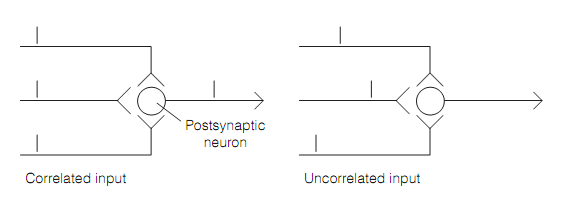Precise timing by neurons
The Rate coding depends on mean firing frequency, and therefore cannot be used to encode the precise timing of events. However there is considerable evidence which precise timing is vital for many neural functions and under these circumstances the brain uses the temporal coding. This is where correct spike timing or high frequency firing fluctuations carries timing information. The Studies of cat visual system illustrate that the resolution of temporal coding is on a millisecond timescale. There are numerous different temporal coding mechanisms and all rely on features other than the mean firing frequency. The temporal coding is used for exact timing of events and as a way in which the firing of a lot of neurons can be synchronized.
The precise timing of events uses the correlation detection which is as shown in figure. The Correlated inputs, those occurring within a short time of each other, raise the probability that a neuron will fire. The Uncorrelated inputs will decrease spike probability. Exactly how close in time the inputs should be depends on the extent of the temporal summation of the inputs and this depends on the time constant of the neuron. The Neurons with fine dendrites or being bombarded by several ipsps, that consequently have short time constants, will correlate the inputs only if they are very close altogether. This permits for high precision timing.

Figure: firing probability of postsynaptic cell based on accurate timing of inputs.
The Pyramidal cells in the cortex are considered to act as coincidence detectors in this way and modulate their behavior to inputs arriving just 5 ms apart. The Coincidence detection underlies the way in which the brainstem permits small differences in entrance time of a sound in the two ears to be used by the auditory system to help localize the sound source.